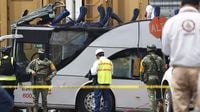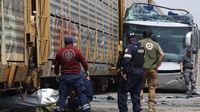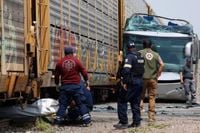In the early hours of Monday, September 8, 2025, a devastating collision between a freight train and a double-decker passenger bus in Atlacomulco, northwest of Mexico City, left at least 10 people dead and more than 40 injured. The accident, which unfolded in an industrial area filled with warehouses and factories about 80 miles (130 kilometers) from the capital, has raised urgent questions about rail safety and the growing risk at Mexico’s grade-level crossings.
According to the State of Mexico’s civil defense agency, the crash occurred as the bus, operated by the Herradura de Plata line, was making its way across a set of tracks on the Atlacomulco–Maravatío federal highway in the Las Mercedes neighborhood. The train, run by Canadian Pacific Kansas City de México (CPKC de México), was reportedly transporting cars northward when it slammed into the bus at its midpoint, literally ripping the vehicle in two. The force of the impact was so great that the bus’s roof was torn off, and the front and rear halves came to rest on opposite sides of the tracks.
Security camera footage reviewed by multiple outlets, including the Associated Press and El Financiero, showed the bus slowly moving across the tracks in heavy morning traffic when the fast-moving train appeared out of nowhere and struck. Cars had been crossing just moments before, and a motorcycle darted across the rails seconds ahead of the crash. Witnesses noted there were no visible crossing gates or stop lights at the intersection—a critical detail that has fueled debate in the aftermath.
“We heard a crash. We thought it was just a car. We never thought it would be a bus with so many people aboard,” said Miguel Sánchez, a 33-year-old service station worker located about 100 yards from the scene, as reported by the Associated Press. He described hearing the train horn well in advance of the crossing, a routine warning that tragically went unheeded this time.
Emergency services responded swiftly, ferrying the injured to hospitals throughout the State of Mexico. Some victims were reported in serious condition, and the death toll, initially reported as eight, was soon revised to 10 as more details emerged. At least six of those killed were women, according to Reforma. The bus was reportedly en route to Mexico City, carrying workers—including domestic workers, as recounted by Rebeca Miranda, who lost her sister’s daughter-in-law in the crash.
“It’s really unfortunate. Why? To beat the train. Those are lives,” Miranda told reporters as she waited by the tracks, torn between supporting her hospitalized sister and finding out what would happen to her relative’s body. Her words echoed a sentiment of frustration and disbelief that has rippled through the community.
Videos circulating on social platforms painted a harrowing scene: the bus’s upper deck exposed, people moving dazed on what remained of the top level, and a woman’s desperate cries—“Help me, help me”—ringing out as the train came to a stop. City officials in Atlacomulco urged residents to stay away from the crash site, expressing their “sincere solidarity to the families affected at this time,” according to a statement posted on social media.
The State of Mexico’s prosecutor’s office quickly opened an investigation, and the bus driver was reportedly arrested, though his condition was not immediately known. The bus company, Herradura de Plata, did not immediately respond to requests for comment. Meanwhile, Canadian Pacific Kansas City de México confirmed the accident and expressed its condolences: “CPKC de México regrets the deaths and expresses its deepest condolences to the families,” the company said, pledging full cooperation with authorities and a commitment to provide all necessary information for the investigation.
As authorities worked the scene, the lack of crossing gates or warning signals at the accident site became a focal point. Witnesses described how, in the moments before the crash, cars in the opposite direction had stopped, but the bus pressed forward—seemingly attempting to cross the tracks before the oncoming train. This detail was corroborated by a statement from CPKC de México, which said the passenger bus was attempting to “beat” the train across the tracks.
Sadly, this is not an isolated event. According to a recent report from Mexico’s Rail Transportation Regulating Agency, published in September 2025, accidents at grade-level crossings are both the most common and the fastest-growing type of rail incident in the country. The agency recorded 800 such accidents last year, up from 602 in 2020. The report did not specify how many victims were involved, but the trend is clear—and deeply troubling. Just last month, six people died when a train hit several vehicles in Guanajuato state, and in 2019, nine people lost their lives in a similar bus-train collision in Querétaro state.
The Atlacomulco tragedy has reignited longstanding concerns about infrastructure and public safety. Many crossings in Mexico, especially those in busy or industrial zones, lack basic warning systems such as gates, lights, or even clear signage. The absence of such protections leaves drivers to rely on their own judgment—a risky proposition in the chaos of morning commutes and heavy traffic.
For families like Rebeca Miranda’s, the consequences are heartbreakingly personal. “Those are lives,” she repeated, her grief mingled with anger at what she saw as a preventable disaster. Her story is echoed by many others who have lost loved ones at unprotected crossings, and by the survivors who now face long recoveries and uncertain futures.
As authorities continue their investigation, attention has turned to what can be done to prevent future tragedies. Some local officials have called for immediate upgrades to crossing infrastructure, while others have urged a broader public education campaign to raise awareness about the dangers of trying to outrun trains. The bus driver’s arrest is likely to be scrutinized as details emerge about the precise sequence of events and any possible contributing factors.
For now, the industrial town of Atlacomulco is left to mourn its dead and care for its wounded, even as the rest of the country grapples with the sobering reality: at Mexico’s rail crossings, the margin for error is often perilously thin, and the price of a split-second decision can be unbearably high.



